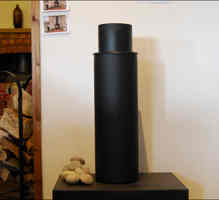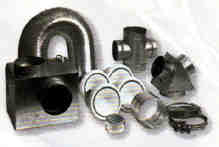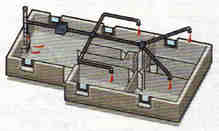Getting more from solid fuel
Presumably, having read this far you are reasonably persuaded by
the merits of solid fuel appliances as a heating source for you home,
workshop, premises etc. Or maybe you just like staring into a fire?
In terms of bang for buck not much beats a dry burner installation,
and the majority of installations are just this. The next step is
often seen as a wet installation, namely using a solid fuel burner to
heat water either indirectly in a water storage cylinder to provide
hot water or directly into a sealed central heating system to provide
heat in multiple rooms. Some manufacturers have the facility to have
a boiler installed at a later date such as Aarrow and Villager but
most are intended to be wet from the outset. The traditional way of
linking a burner to central heating was via heat exchangers and heat
store. The new way pioneered by Broseley allows the burner to be an
secondary input into a combi boiler system with not much more than a
low loss header (a custom made pipe with multiple inputs and outputs
such as this one).
At present I do not know if burners other than those supplied by Broseley
can be connected to such a system, but cannot see why not. There are two other
methods of getting heat from a dry installation spread around the
house.
- Firstly a flue boiler such as that made by Charnwood, which is a
wet system added to an existing flue pipe.

- Secondly there are convection burners.
Convection burners at their most basic pull in air around the
firebox, warm it, convect it out a vent in the appliance. Burners such as
Grey Metal's 'Cube' operate
like this. The next step up is an appliance with built in ports for
hot air ducting pipes to be attached. Popular in France but rarely
seen in the UK.
 A third option is a dry flue boiler not dissimilar to
that made by Charnwood combined with dry ducting, another French
innovation. Ducting has the advantage that a dry installer can
complete the task and less involvement with Building control officers.
However the Charnwood system probably has the edge as regards
performance.

|
Ways to get more from dry installations |
| 1. |
Don't line the flue |
Unlined flues allow
more heat to be conducted into the masonry providing more heat
into the room above, too much heat loss can however cause the
gases to condense and create the conditions for a chimney fire.
When installers cite flue 'efficiency' as a reason for lining
ask them exactly what they mean! |
| 2. |
If you have exposed
pipe work fit a Charnwood flue boiler |
Charnwood manufacture
flue boilers with outputs up to 3.4kW. Charnwood claim that
these boilers will provide enough heat to power 3 radiators or
most domestic hot water requirements with minimal effect on the
dry burner or chimney. From £300ish via
Bradley Stoves near Horsham.
www.charnwood.com |
| 3. |
Hot air ducting |
Popular in France,
I've struggled to find a UK supplier. Usually powered by a small
electric motor 40-70W, often connected to an inset burner with
three 'exhaust' ports. one for the flue gasses and the other two
for cold air in and hot air out. Ducting is usually 5" (125mm)
or 6" (150mm). Capable of having multiple ducts. |
| 4. |
Burner fans |
Never used one myself
and I can't decide if they are a gimmick or really rather clever
but £100 seems to buy one.
www.bhl.co.uk |
| 5. |
Insulate |
Stop or slow heat
transfer to unwanted places. Generally speaking around a solid
fuel appliance use not just a non combustible but a flame
retardant such as Rockwool or vermiculite. That said I have seen
Rockwool singed by an inset appliance over many years use. |
| 6. |
More energy dense
fuels |
Mineral fuels
routinely have kW per kg of over 8. Some
smokeless fuels reach
9.16. If wood is your thing certain species of tree provide
significantly better fuel than others,
see this link. Eco logs have a kW per kg of near 14, a usual
burn time is approximately 3 hours per log. |
| 7. |
Sealed air intake |
Burley
amongst other manufactures offer a room sealed air intake system
for their burners, I don't understand how this makes burners
more efficient, but it does and Burley currently hold the crown
for the worlds most efficient solid fuel appliances. |
| 8. |
Fit an efficient
appliance |
Not wishing to sound
like advert for
Burley
or Broseley but
fitting an appliance with an efficiency over 80% puts you into
the premier league of solid fuel appliances.
See this
link for more information. |
| 9. |
Use dry fuel |
Wood at 0% moisture
(kiln dried) wood gives 100% or close to of it calorific value
in heat, when burnt. However at 20% moisture only 81% and at 50%
moisture (green) as low as 62%. Similar figures apply to coal
and anthracite. I sell
moisture meters for measuring these figures. |
| 10. |
Match the appliance to
setting and use |
A few rules of thumb,
inset appliances take longer to warm the rooms they are in but
retain the heat for longer. Convection appliances generate heat
faster. High mass burners can often take a long time to warm up
due the mass of the appliance, steel generally has less mass
than cast iron, the 12kW Firefox is notably slow to warm-up. |
| I
appreciate that most of these options have to be considered at
the moment of installation, and are difficult to retro fit |
|

